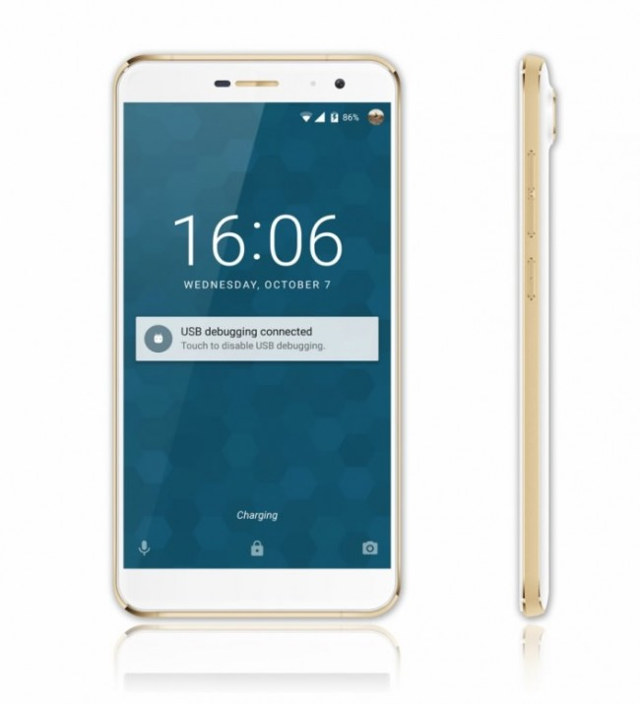Flagship Android smartphones now ship with processors featuring Cortex A72 cores, or custom variants from Samsung or Qualcomm, and normally cost several hundred dollars. Some new smartphones recently announced with MediaTek Helio X20 deca-core processor lower the price barrier in the $250 to $400 range, but at least two upcoming models will bring the cost below $200: Doogee P7 ($169.99), and Vernee Apollo Lite ($199.99). So let’s see what we’ve got for those prices.
Doogee P7
 Doogee P7 (preliminary) Specifications:
Doogee P7 (preliminary) Specifications:
- SoC – Mediatek Helio X20 (MT6797) deca-core processor with 2x Cortex A72 cores @ 2.5 GHz, 4x Cortex A53 cores @ 2.0 GHz, and 4x Cortex A53 cores @ 1.4 GHz and ARM Mali-T880MP GPU @ 850 Mhz
- System Memory – 3GB RAM
- Storage – 16 GB storage and micro SD slot up to 64GB (shared with dual SIM slot)
- Display – 5.5″ capacitive touchscreen, 1920×1080 resolution; 160K colors
- Cellular Connectivity
- 2G – GSM 850/900/1800/1900MHz
- 3G – WCDMA 900/2100MHz
- 4G – FDD LTE Band 1/3/7/8/20
- Dual SIM Card Dual Standby (One Micro SIM Card)
- Connectivity – 802.11 b/g/n WiFi, Bluetooth 4.0, GPS/A-GPS, and FM radio
- Camera – 13.0 MP rear camera with flash and auto-focus, 8.0 MP front-facing camera
- USB – 1x micro USB OTG port
- Audio – Speaker, microphone, and 3.5mm audio jack
- Sensors – gravity, others? (TBD)
- Battery – 3600 mAh battery
- Dimensions – 159.6 x 82.1 x 9.5 mm
- Weight – 170 grams
The phone will run Android 6.0, and ships with a charger and USB cable. You can find some more details on DoogeeMobile, where they show the $169.99 price tag in comments (likely without shipping). There will also be a Doogee P7 Pro version with 32GB storage and 4GB RAM, better camera and display that should sell for $200. It’s unclear when the two versions of the phone will be available, as they keep postponing them.
Vernee Apollo Lite
 Vernee Apollo Lite is the little brother of Vernee Apollo with Helio X20, 6GB RAM, and 128 GB, but selling for half price thanks to lower, but still decent (preliminary) specifications:
Vernee Apollo Lite is the little brother of Vernee Apollo with Helio X20, 6GB RAM, and 128 GB, but selling for half price thanks to lower, but still decent (preliminary) specifications:
- SoC – Mediatek Helio X20 (MT6797) deca-core processor with 2x Cortex A72 cores @ 2.5 GHz, 4x Cortex A53 cores @ 2.0 GHz, and 4x Cortex A53 cores @ 1.4 GHz and ARM Mali-T880MP GPU @ 850 Mhz
- System Memory – 4GB RAM
- Storage – 32 GB storage + micro SD slot
- Display – 5.5″ capacitive touchscreen, 1920×1080 resolution
- Cellular Connectivity – No details yet; Dual SIM Card Dual Standby (SIM + SIM, or SIM + micro SD configuration)
- Connectivity – TBD
- Camera – 16.0 MP rear camera, 5.0 MP front-facing camera
- USB – 1x USB type C port
- Sensors – Compass, gyroscope
- Battery – TBD
- Dimensions – TBD
- Weight – TBD
The phone will also run Android 6.0, and is expected to launch in May for $199.99 + shipping. The company announced the phone on their Facebook page.
Even though the complete specifications are not available for Apollo Lite and Doogee P7, both devices appear to be pretty good smartphones considering the price point.

Jean-Luc started CNX Software in 2010 as a part-time endeavor, before quitting his job as a software engineering manager, and starting to write daily news, and reviews full time later in 2011.
Support CNX Software! Donate via cryptocurrencies, become a Patron on Patreon, or purchase goods on Amazon or Aliexpress




